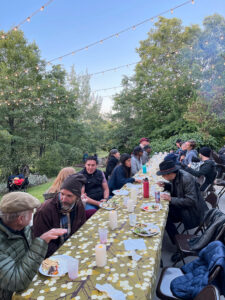A Wider Perspective
“To discern larger patterns on the dance floor—to see who is dancing with whom, in what groups, in what location and who is sitting out which kind of dance —we have to stop moving and get to the balcony.”
—RONALD A. HEIFETZ, FOUNDER OF THE CENTER FOR PUBLIC LEADERSHIP AT HARVARD UNIVERSITY’S KENNEDY SCHOOL
Ronald Heifetz in “Leadership Without Easy Answers,” his well-regarded book on leadership, encourages leaders facing complex challenges to “get on the balcony,’’ a metaphorical place where they can have a better view of what is occurring around them. In other words, the esteemed leadership expert—whose early work on leadership Lilly Endowment was pleased to support—advises leaders to take time to gain a wider perspective on what is happening in their organizations and the contexts in which they conduct their affairs.
 FOR MANY YEARS, WE AT THE ENDOWMENT have found that gaining a wider perspective is vital for our work and that of the organizations we support. Heifetz’s image of the “view from the balcony” in fact resonates with the advice of one of the Endowment’s founders, J.K. Lilly Sr. (right), who told his associates in the early part of the 20th century when he was hiking with them through a forest in southern Indiana: “Always cut a place for a lookout…Always have a vista.”
FOR MANY YEARS, WE AT THE ENDOWMENT have found that gaining a wider perspective is vital for our work and that of the organizations we support. Heifetz’s image of the “view from the balcony” in fact resonates with the advice of one of the Endowment’s founders, J.K. Lilly Sr. (right), who told his associates in the early part of the 20th century when he was hiking with them through a forest in southern Indiana: “Always cut a place for a lookout…Always have a vista.”
One principal way we assist organizations in widening their perspectives is by providing planning grants to help them identify and study their strengths and challenges, test assumptions, confirm or refine their missions, ensure their endeavors are inclusive by seeking the input of diverse stakeholders, and prioritize and develop strategies to address their challenges and opportunities. Planning grants are used to fund, among other things, convenings, interviews, focus groups, consultants, the collection and analysis of pertinent data and the preparation of proposals for grants to implement strategies developed as a result of planning activities.
This annual report features stories about our grantmaking in community development, education and youth, and religion that highlight how planning grants gave organizations the time and space to stimulate creativity, engage a diverse range of views, imagine collaborative approaches to promote synergies, achieve greater efficiencies and discern how to pursue their missions more effectively.
 A story about our work in community development details how a planning grant helped Easterseals Crossroads to research best practices in providing job training and other kinds of support for individuals with disabilities; to bring together staff and board members for brainstorming sessions; and to seek input from employers and other community partners. The planning grant, made through the Endowment’s Enhancing Opportunity in Indianapolis initiative, led to an implementation grant that is funding high-impact, intensive services for individuals with disabilities experiencing financial insecurity that are putting them on a path to well-paying jobs and economic self-sufficiency.
A story about our work in community development details how a planning grant helped Easterseals Crossroads to research best practices in providing job training and other kinds of support for individuals with disabilities; to bring together staff and board members for brainstorming sessions; and to seek input from employers and other community partners. The planning grant, made through the Endowment’s Enhancing Opportunity in Indianapolis initiative, led to an implementation grant that is funding high-impact, intensive services for individuals with disabilities experiencing financial insecurity that are putting them on a path to well-paying jobs and economic self-sufficiency.
Another story describes the impact of planning grants that Indiana community foundations received through Phase VII of the Endowment’s initiative, Giving Indiana Funds for Tomorrow (GIFT). The Warren County Community Foundation used its planning grant to engage in conversations with a broad range of residents, which led the foundation to prioritize for this grant opportunity improving recreation areas, particularly in and around the Williamsport Falls, to strengthen their community’s quality of life. The Community Foundation Serving Howard, Clinton & Carroll Counties used planning grant funds to engage a diverse array of residents in gatherings, focus groups and interviews about the communities’ most pressing challenges. With this input, foundation leaders developed a deeper understanding that issues relating to mental health and substance use disorders were critical community concerns and led to the recent opening of a comprehensive mental health and addiction treatment center.
 In the area of education and youth, the report features a story about the Girl Scouts of the USA and Boys & Girls Clubs of America, two of nine national youth-serving organizations that received planning grants in 2022 through the Endowment’s initiative, Strengthening Youth Programs in Indiana: National Organizations and Affiliates. The featured organizations used planning grants to work closely with leaders of their Indiana affiliates to identify the most pressing challenges they face. Planning helped them to understand better the barriers that keep young people from participating in their programs and to collaborate on developing new programs and approaches to reach more youth. The organizations placed a focus on serving youth from communities of color, youth from low-income families and immigrant families, and youth who have been affected by trauma and other adverse childhood experiences.
In the area of education and youth, the report features a story about the Girl Scouts of the USA and Boys & Girls Clubs of America, two of nine national youth-serving organizations that received planning grants in 2022 through the Endowment’s initiative, Strengthening Youth Programs in Indiana: National Organizations and Affiliates. The featured organizations used planning grants to work closely with leaders of their Indiana affiliates to identify the most pressing challenges they face. Planning helped them to understand better the barriers that keep young people from participating in their programs and to collaborate on developing new programs and approaches to reach more youth. The organizations placed a focus on serving youth from communities of color, youth from low-income families and immigrant families, and youth who have been affected by trauma and other adverse childhood experiences.
The youth programs of Calumet College of St. Joseph and DePauw University, two of 27 Indiana colleges and universities that received planning grants in 2022 through the initiative, Indiana Youth Programs on Campus, are also highlighted in the education section of this report. The schools used planning grants to identify their campuses’ unique strengths and the summer programming needs and interests of youth. They then designed responsive, campus-based summer youth programs, with a focus on youth from populations that have been underserved by higher education, many of whom have never set foot on a college campus. Implementation grants are helping both institutions conduct their programs, which are introducing youth and their families to what higher education can offer.
A third education story describes how the Endowment is allocating up to $85 million to support efforts to improve reading instruction for children in kindergarten through second grade in Indiana schools through the use of evidence-based teaching practices aligned with the Science of Reading (SoR). Planning grants to 31 Indiana colleges and universities are helping them consider how to incorporate SoR-aligned curricula into their teaching preparation programs. And a grant to the Indiana Department of Education is supporting its efforts to provide coaching and professional development in SoR teaching practices for a majority of Indiana’s current kindergarten, first and second grade teachers.
 The report also includes two religion stories. One features the collaborative learning of the Parish Collective supported by a planning grant through the Endowment’s Thriving Congregations Initiative. Based in Seattle, Parish Collective’s mission is to help congregations thrive by encouraging them to discern how God is calling them to develop their ministries through a sharper focus on what is happening in their neighborhoods. The planning grant helped the organization conduct listening sessions with congregation leaders outside its homebase in the Pacific Northwest to learn about what’s happening in various faith communities and their increasingly diverse neighborhoods in southern California and in the Chicago area. An implementation grant is helping the organization extend its network to 12 cities across the country.
The report also includes two religion stories. One features the collaborative learning of the Parish Collective supported by a planning grant through the Endowment’s Thriving Congregations Initiative. Based in Seattle, Parish Collective’s mission is to help congregations thrive by encouraging them to discern how God is calling them to develop their ministries through a sharper focus on what is happening in their neighborhoods. The planning grant helped the organization conduct listening sessions with congregation leaders outside its homebase in the Pacific Northwest to learn about what’s happening in various faith communities and their increasingly diverse neighborhoods in southern California and in the Chicago area. An implementation grant is helping the organization extend its network to 12 cities across the country.
The other religion story explores how a planning grant to the Presbyterian Church U.S.A. through the National Initiative to Address Economic Challenges Facing Pastoral Leadership helped denomination leaders understand how challenges of financial insecurity were affecting their pastors. Through data about pastors’ salaries and education debt and the insufficiency of retirement funds for clergy, they learned that pastors needed debt relief and improved financial literacy. Programs addressing these and other needs have been developed so clergy can better serve their congregations.
These stories provide only a glimpse of the passionate commitment and unceasing efforts of the thousands of people who carry out the missions of the organizations we are privileged to support. Given the fast-paced and complex world in which we live, many of them can only attend to the daily challenges their organizations face. We observe, and they tell us time and again, how valuable gaining a wider perspective is to their ability to further their missions and to improve the quality of life of the individuals, families and communities they serve. We are pleased to be able to help provide them the time and space to get on a “balcony,” and to “cut a place for a lookout” with a new vista.

N. Clay Robbins
Chairman & Chief Executive Officer

Jennett M. Hill
President
Transitions
We acknowledge with gratitude the contributions of three colleagues who provided decades of service to the Endowment.
Julie Siegler, vice president for administration, retired in 2022 after 31 years of exemplary work at the Endowment. Over the years, she played pivotal roles for us in grants administration, financial services, human resources and building management. We miss her gracious and fun-loving personality, which enhanced greatly our staff morale.
Sharon Minner, grant coordinator in education, retired in 2022 also after 31 years at the Endowment. For many years, she was a key member of our central services staff. In 2007, she began applying her exceptional organizational skills to her role as grant coordinator in education. We also are deeply grateful to her for leading our staff’s charitable giving program at Christmas for some 30 years.
Finally, we were profoundly saddened by the untimely death of Tracie Stuart in April 2022. Also a member of the Endowment’s staff for 31 years, she was director of central services and guest services at the time of her death. Known for her efficiency and style, Tracie is greatly missed. We continue to be thankful for the ways she touched our lives and for her many contributions to the Endowment and its work.